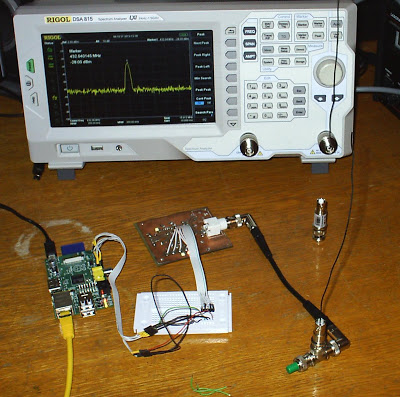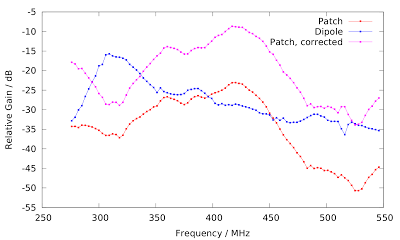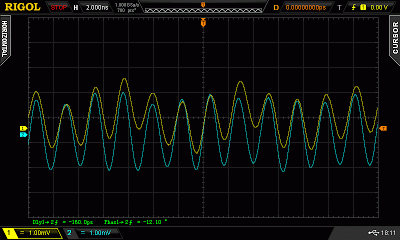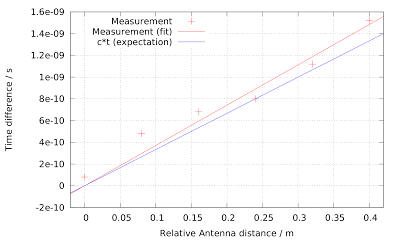As you probably do not know, I’m currently trying to build a semi-digital radio interferometer at 408MHz, for astronomy. I played around a bit with patch antennas, and did some very basic “interferometry” tests with them.
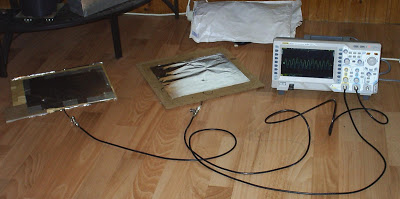 |
| Some extremely bad tinfoil patch antennas being used for “interferometry” |
Basic idea of how this interferometer could work
The plan for this telescope goes something like this:
- There’s an arbitrary number of antennas (the more the better) which receive radiation from every direction equally.
- Those antennas are distributed across… uhm… my garden with some yet-to-determine fancy arrangement.
- Attached to each antenna individually is a carefully crafted low-noise preamplifier, a filter (to filter out everything not in the 408MHz band), and at least one more amplifier stage (to make up for losses in the cable) using some random cheap integrated circuit amplifier.
- Coaxial waveguides of some arbitrary, but known length go from each antenna to a central point. At this central point there’s a computer-controllable input multiplexer which selects two of the antennas. The signal of one of the antennas is delayed by a delay line (some more coaxial cable) to make signal travel time from the observed source (e. g. the sun) to the central point roughly equal.
- Some more (cheap integrated circuit) amplifiers and filtering stages happen after the delay line and multiplexer. The amplifiers possibly need to be switchable in order to ensure that the signal amplitude is within the allowed range (roughly -60dBm to +0dBm) for the next step.
- The phase and magnitude of the signal of the two antennas selected by the multiplexer is compared by an AD8302 or similar chip.
- The resulting phase difference is sampled by an analog-digital converter, and saved to disk.
- This is done repeatedly for all pairs of antennas. I imagine switching to happen several thousand times a second. This should not be a problem since all the used circuitry supports this (e. g. the switches need ~40ns to operate, the ADC should be sufficiently fast, …).
- This information, together with information about the arrangement of the antennas, allows to reconstruct the radiation pattern, i. e. an image of the sky.
Current state
The current state of the project is roughly as follows:
- The delay line is done, it seems to work okay. It currently allows up to 150ns delay in 10ns steps, and it could be extended by one or two more powers of two by just adding cable. It might be necessary to redesign the PCB to maintain the signal integrity better, it’s sort of lossy currently, but basically this problem can be considered as solved (I know what changes to the PCB would be required but I’m too lazy to do them until it proves to be not good enough).
- There’s a prototype for the preamplifier based on this, but it needs to be adjusted to have lowest noise-figure at 408MHz.
- There’s a prototype for the antennas. More about that below.
- There’s a very rough prototype for software which reconstructs the sky brightness distribution which works on simulated data.
- I have investigated how to do the phase comparison, but a suitable PCB layout might be a bit of a challenge. Should be doable tough. Maybe it would make sense to pay for a professionally manufactured PCB (with proper vias etc.) here.
- I have selected a chip for the integrated amplifier to be used at the antennas; that part should be reasonably easy to design and build.
- There’s no plans for the input multiplexer but I expect this to be sort of trivial (just a cascade of switches should be enough, or maybe I can even find a dedicated RF multiplexer chip).
- A major point to find a solution for is a good implementation for the filter stuff. The filter must be quite narrow (1%), reasonably easy and cheap to build, and should have a low loss as its peak frequency. I have considered microstrip filters and traditional lumped component filters, but neither seem quite optimal.
Patch antennas
But now, something about patch antennas! I think this kind of antenna is sort of suitable for my purpose as it is easy to build and design, nicely storable and transportable, and especially because it has a very uniform radiation pattern in all directions (which i want) except downwards — when using a ground plane (which I want too). So I built some really really bad prototypes from tinfoil, tape and cardboard, and with almost-as-bad measurement techniques, I determined that they have roughly the expected properties.
I used a quarter-wave dipole (fancy word for “20cm long piece of wire”) and a (low output-power) frequency synthesizer as a sender, and made the frequency synthesizer sweep through different frequencies, then measured the intensity of the signal at the patch antenna, which was placed next to it (see image above). This gives the red curve in the diagram below:
Doing some correction because the dipole also has a non-flat frequency response gives the pink curve, which shows that the design goal of having an antenna which is good at 408MHz was roughly achieved… probably.
Good, so now let’s do some “interferometry” with it! I turned on the frequency synthesizer with its wire antenna at 432MHz (since I thought that even if someone outside my house should be able to receive the few-microwatt signal, it will probably not cause major issues when in this band) and aligned my two test-patch antennas to have the same distance from the transmitter wire. This gives two sine waves with the same phase, then:
Moving one of the antennas, if only by few centimeters, gives a notable phase shift between the two curves. Moving one antenna repeatedly and measuring the phase shift gives this diagram of signal delay versus distance:
Given that the scope’s sample rate is barely enough to measure the signal’s phase at all, the result seems acceptable. The scope will be replaced by an AD8302 in the final setup.
So, what can we learn from this?
- Unsurprisingly, the “a signal arrives later if the antenna is farther away” stuff works (you still need to check, right?).
- Altough the patch antenna’s frequency response is narrow, a filter is very much needed.
- Patch antennas seem to be a reasonable choice for this project.
- You can’t solder tinfoil. Don’t even try it.
The final version of the patch antennas will probably be built from (foamed?) PE (?) with copper (?) foil on it.
Next steps
The next thing I’ll work on is the filter design. Maybe I’ll build some microstrip filters, just to see how well they work. I’ll write another post if I find something new about that. When the filter design is done, then it’s basically just about putting all the pieces together; most major problems I can imagine are solved then. I’m really excited whether this is going to work at all!
Categories: Everything
Tags: antenna, astronomy, interferometry, radio telescope

